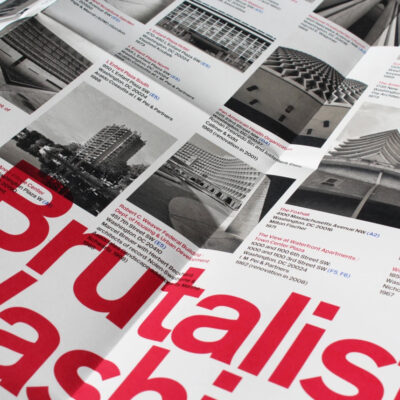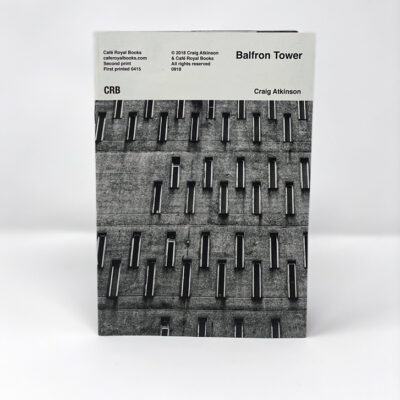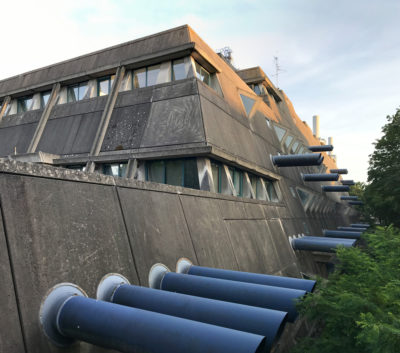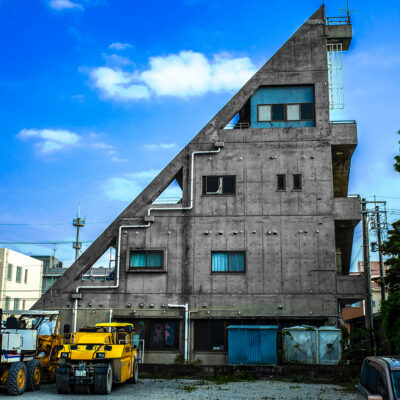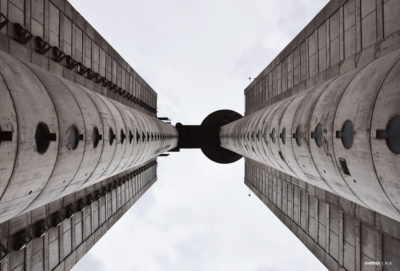#SOSBrutalism
Saving Beloved Concrete Monsters
Focused on one thing, to map brutalist architecture worldwide #SOSBrutalism has over 1900 brutalist buildings in its database and it’s nowhere near done
We got together with architectural historian and member of the #SOSBrutalism team, Felix Torkar, to hear more about why ‘concrete monsters’ are so loved by some and so misunderstood by others. A bit of background, Greyscape recently interviewed Felix about his part in the fight to save Berlin’s Mäusebunker and the Hygieneinstitut.
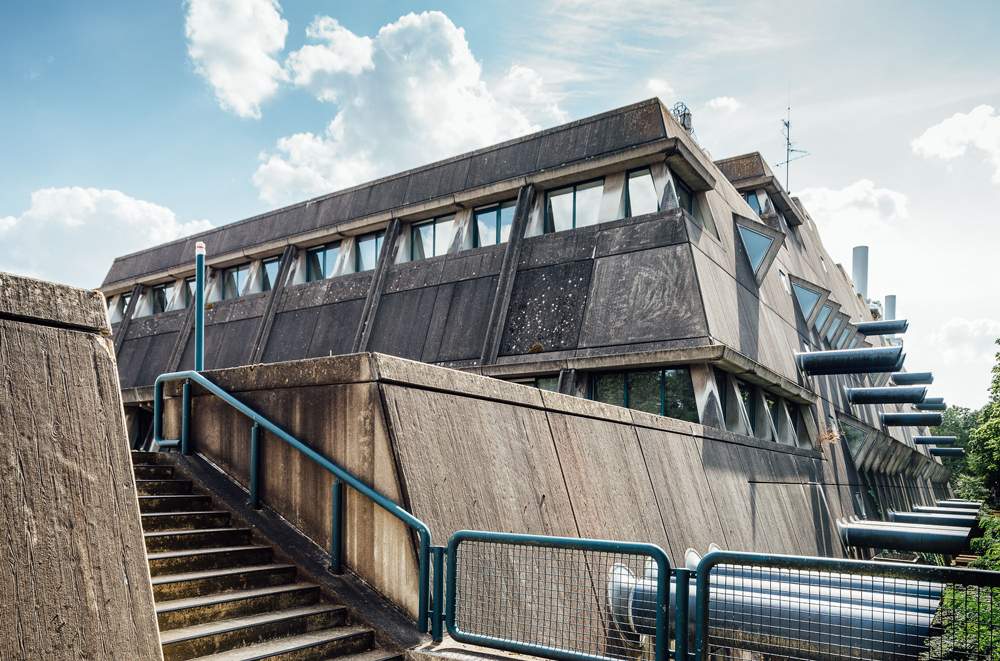
Gerd Hänska / Magdalena Hänska / Kurt Schmersow: Central Animal Labs „Mäusebunker“, Berlin 1971–1980 ©
Tell us about the database and the trigger for its creation in 2015?
It became clear that there simply was no good comprehensive resource for researching Brutalist buildings. Even though the term was coined in the mid-50s by Reyner Banham, it was not widely used by architects themselves, which made it difficult to identify the key projects in different regions.
…what characterises the New Brutalism…is precisely its brutality, its je-m’en-foutisme, its bloody-mindedness.
Reyner Banham, 1955
Meanwhile, social media groups like the Brutalist Appreciation Society on Facebook were bustling with tens of thousands of members, sharing their latest discoveries. The sheer volume prompted us to realise that we should leverage this collective knowledge and make a database. More than simply collecting what’s out there, we also wanted to create a red list of endangered projects to raise awareness. We started by cataloguing all the known buildings. The community aspect is important: we asked the community for their recommendations and in return, we offer this platform as a research tool. Think of it as a platform that both highlights the activities of conservationists and raises awareness of our newest discoveries on social media.
We also established the hashtag #SOSBrutalism as a great way of connecting the fans and conservationists with each other.
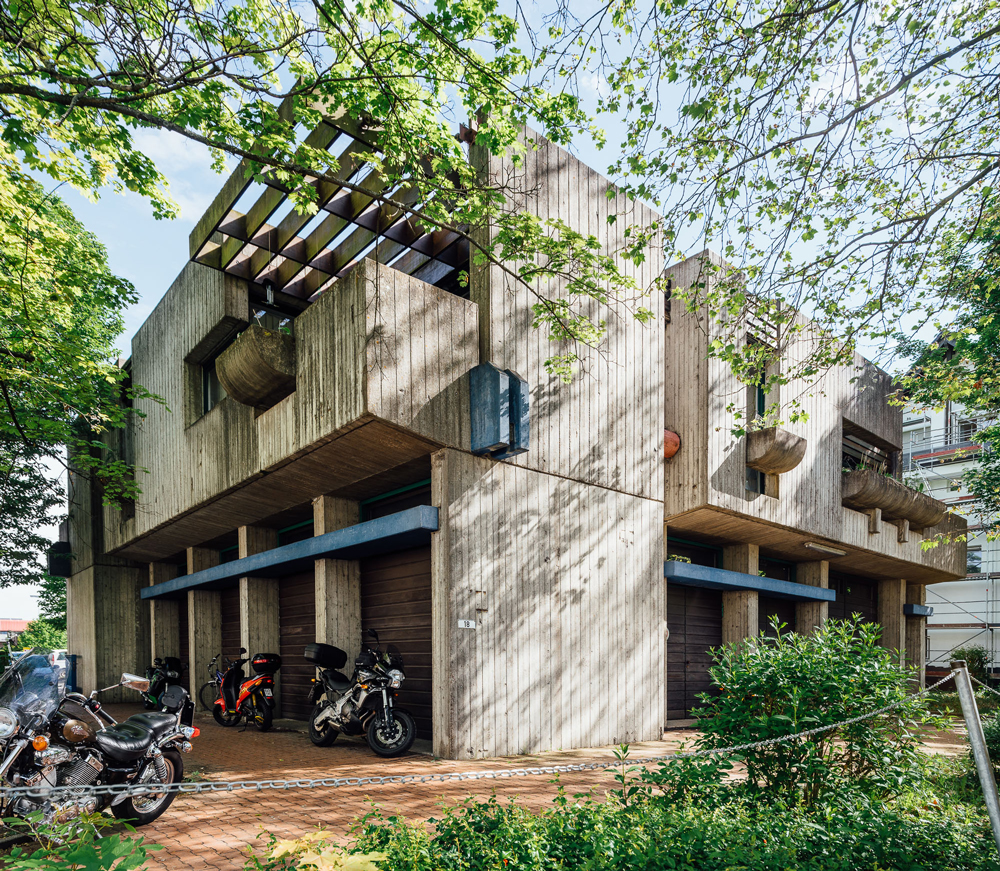
Architect, Johannes Möhrle: former janitor’s apartment of the Central Post Office, Marburg, Germany, 1965–1976 ©
How do you get involved in the project?
In 2017 I joined Deutsches Architekturmuseum (DAM) in Frankfurt am Main as a curatorial assistant. It enabled me to have a hands-on role working with Oliver Elser. He curated the #SOSBrutalism exhibition at the DAM in cooperation with the Wüstenrot Foundation. The exhibition opened in November 2017, receiving 47,000 visitors. It was a huge success and caught the attention of the mainstream press and German prime time TV news. I’m now back in Berlin, three years have passed, and the project is still going strong.
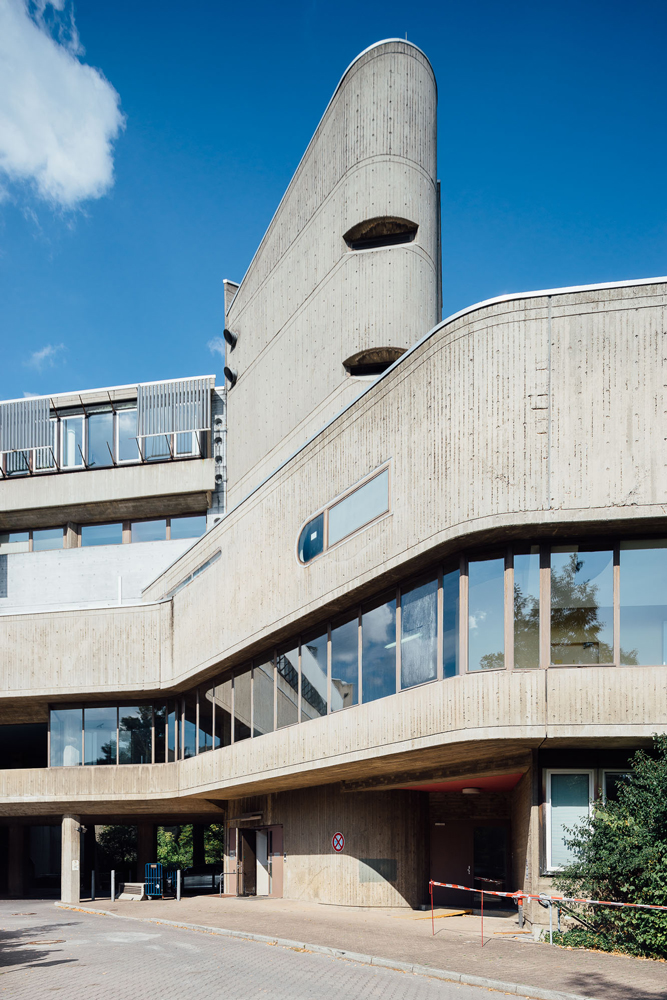
Architects Fehling+Gogel: Institute for Hygiene and Microbiology, Berlin 1966–1974 ©
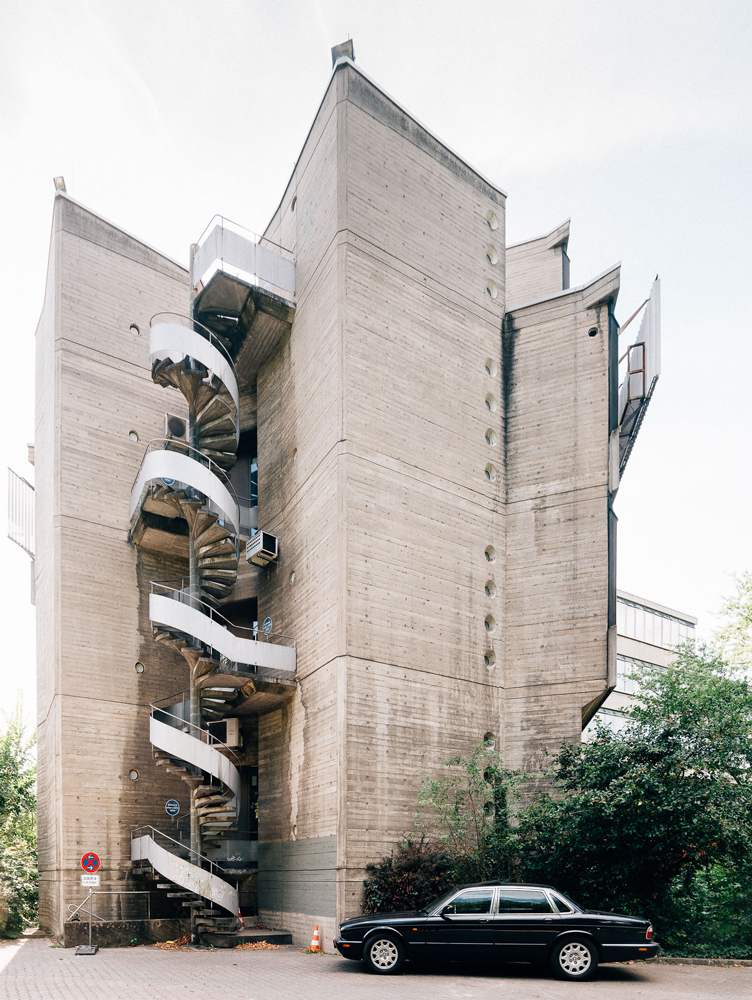
Architects: Fehling+Gogel: Institute for Hygiene and Microbiology, Berlin, Germany, 1966–1974 ©
How many buildings are on the database? Do you see a moment when you can say—that’s it—it’s done… we have every building, or is there an evolutionary element to the project?
The combination of the database and social media efforts with the shout-out to send us suggested inclusions has worked beyond our wildest imagination! We started with 200 to 300 buildings, that we had researched ourselves. Today our database has grown to close to 2000 projects.
To answer your second question: At the start, I had the naive thought that we might be able to just find all the buildings and be done with it one day. But the more you look, the more you see how truly global this architectural approach was and how many examples there are. At this point, it feels as if it is impossible to ever get a complete overview. We still have a long list of buildings waiting to be added with new potential inclusions coming in all the time.
With that in mind: if you know of a Brutalist building that we don’t have in our database, yet, we’d love to hear from you!
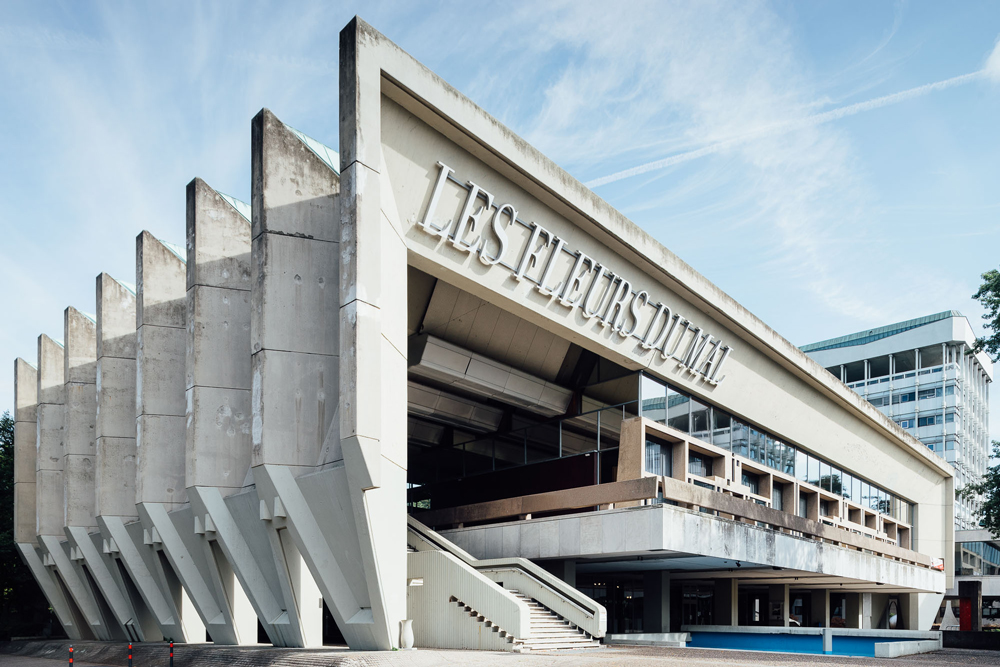
Architects Johannes Van den Broek / Jacob Bakema: City Hall, Marl, Germany, 1959–1967 ©
In your terms what is Brutalism?
Brutalism is an architectural design language, or you could say an approach or an attitude that emerged in the 1950s. It spread rapidly and proliferated until the late 1970s. At its most fundamental level, Brutalism is about radical material, conceptual honesty and openness. Construction materials are exposed, nothing is clad, plastered, painted or otherwise hidden. You can understand the way things were built, how they are holding up and how the building functions just by looking at it. Additionally, there is a certain sense of memorability or rhetoric—
Brutalist designs have strong individual personalities.
It was a rebellion against the slick, non-specific, immaterial glass architecture of the prevalent International Style. What began as an austere post-war style soon turned into a celebration of materials and engineering. The sculptural, gravity-defying possibilities of reinforced concrete in particular (although there is brick Brutalism, as well) led architects to become more and more daring, creating spectacular, monumental designs.
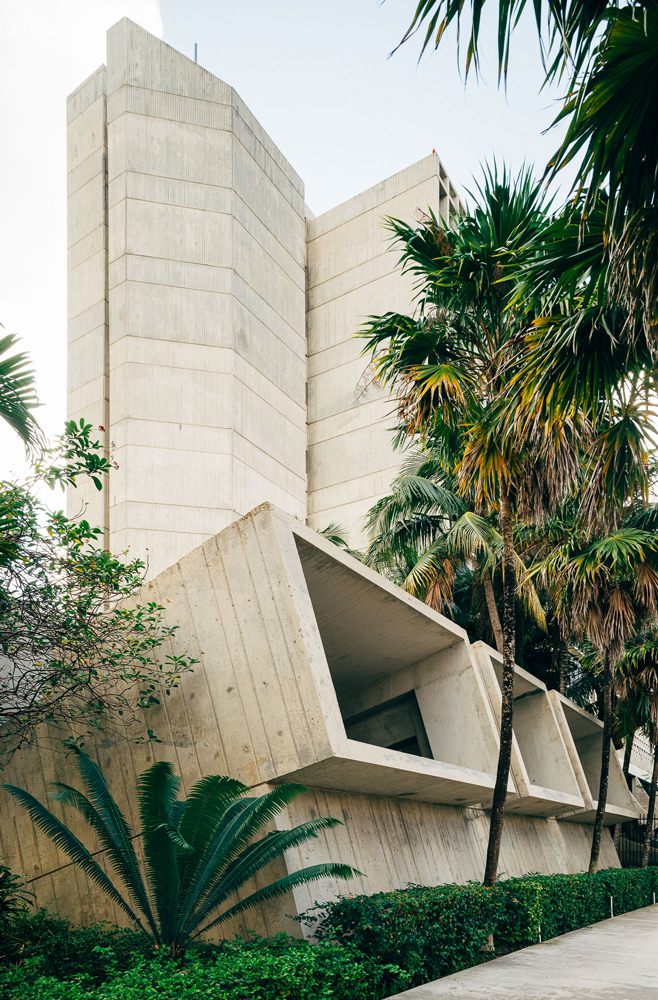
Architects: Ferendino Grafton Spillis Candela: Mailman Center for Child Development, Miami FL 1971 ©
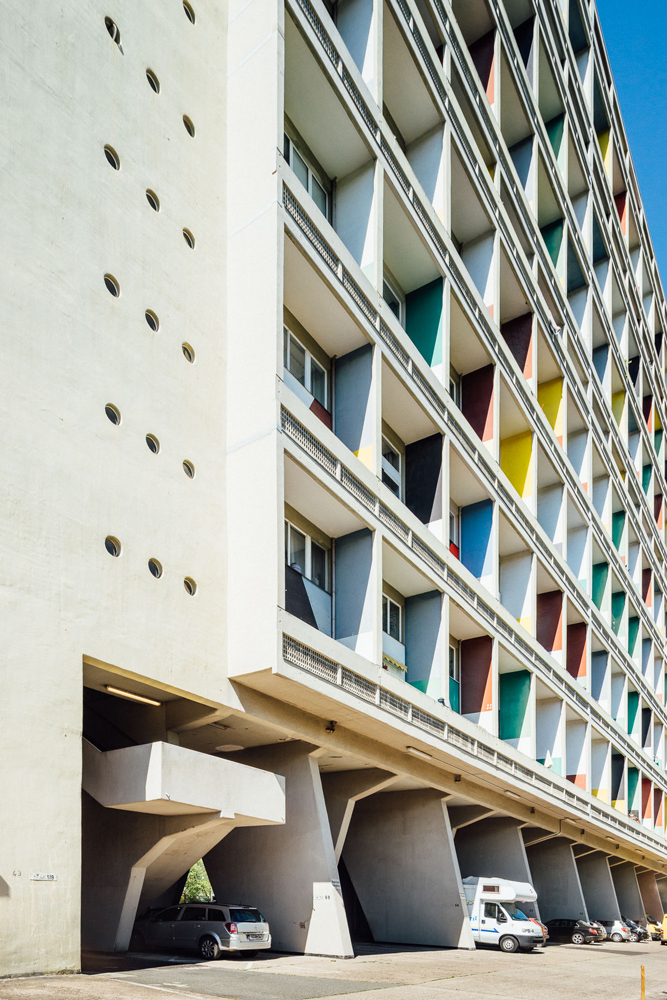
Le Corbusier: Corbusierhaus (Unité d’Habitation Berlin), 1956–1958, Photo: Felix Torkar
How has the public perception of Brutalist architecture evolved since you began the database in 2015?
Projects like #SOSBrutalism have helped change the perception of Brutalist architecture but it is a slow process. For successful preservation, it is important to not only change the minds of architecture fans but to convince the people in key positions, such as public officials or investors. Despite historic setbacks and demolitions, I do think there is a general positive trend towards more awareness.
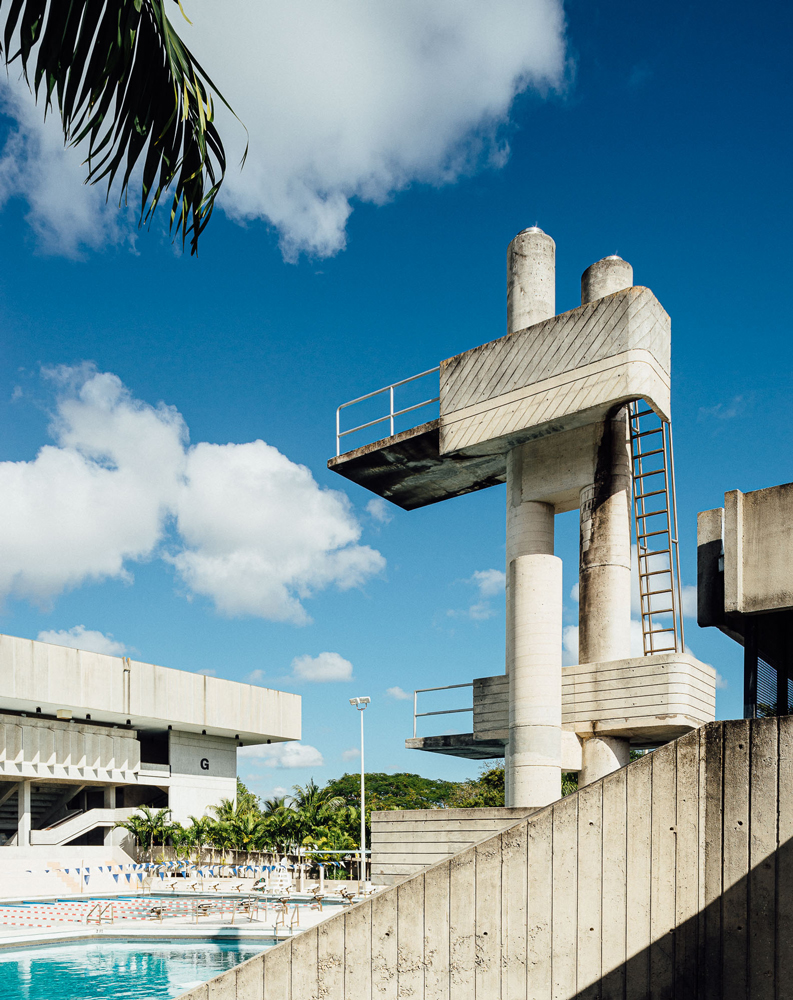
Architects: Ferendino Grafton Skills Candela Pancoast: South-Kendall Campus, Miami Dade College, Miami FL 1963 ©
How do you note the buildings? Are you driven by location/age/architect?
First, our editorial team discuss and determine whether the suggested buildings can be called Brutalist. Despite guidelines, a lot of the decision-making comes from our experience of vetting thousands of buildings. Ultimately, we decide on a case by case basis.
We also limit ourselves from the 1950s up to the early 1980s. Secondly, for architects that were very prolific and built dozens of Brutalist buildings, our aim is not to merely catalogue their whole œuvre, but rather select some key examples of their work. Their smaller projects still make it into the database though, if they are at risk. It is important for us to identify lesser-known architects, so new names are always particularly exciting. Sometimes our database is the only online resource for these structures, and we strive to make them available and searchable for a wider public.
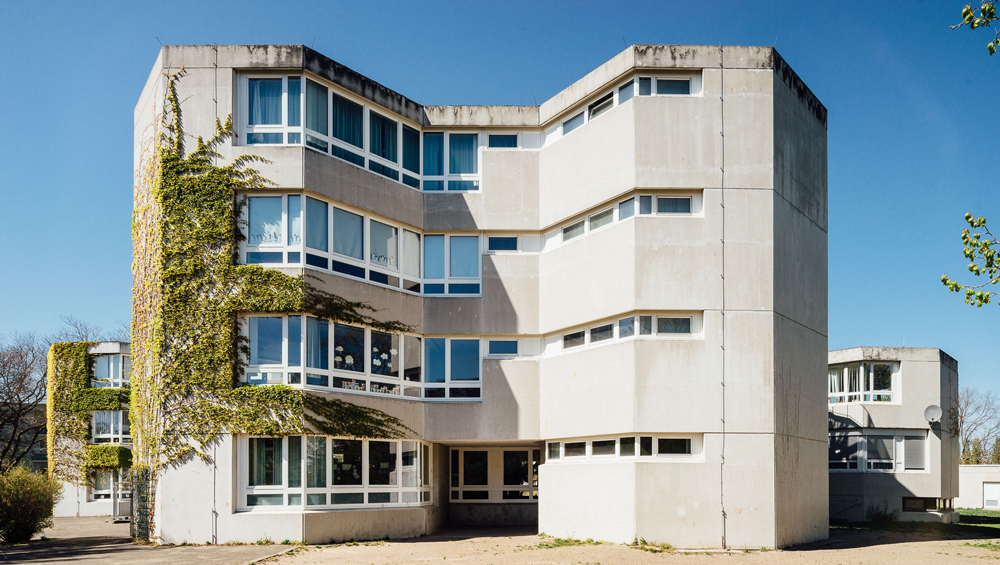
Architects: Dorothea Haupt / Peter Haupt: Reineke-Fuchs-Grundschule, Berlin, 1970–1972
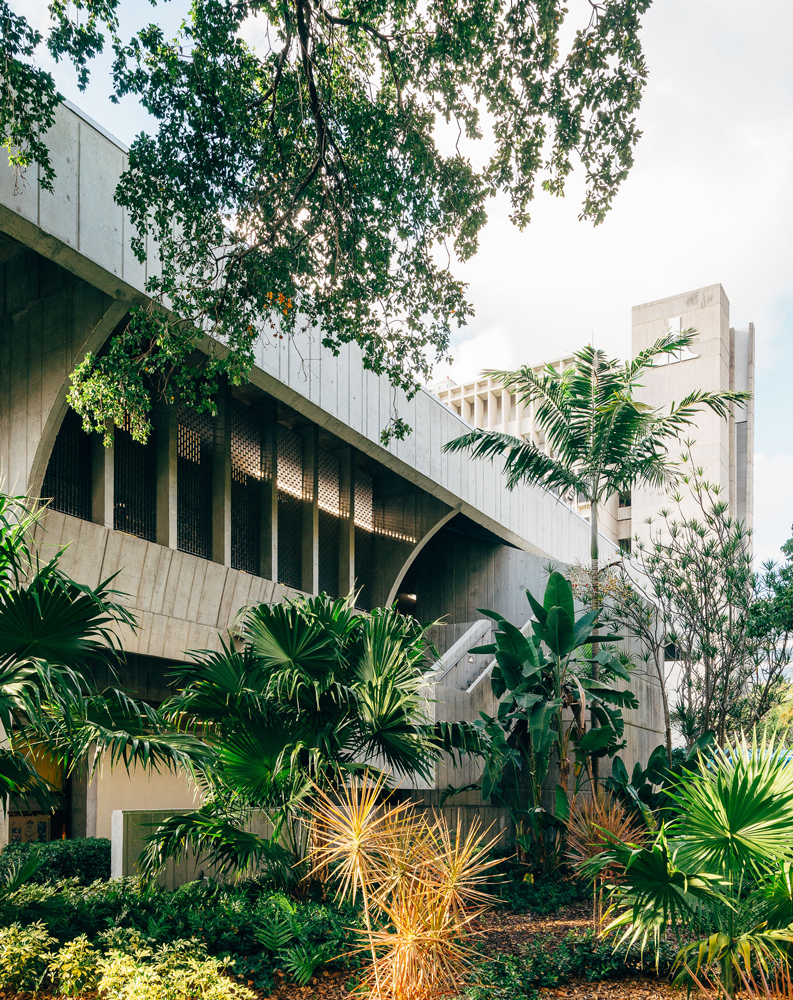
Architects: Ferendino Grafton Spillis Candela: Mailman Center for Child Development, Miami FL, USA, 1971
Which building(s) would you consider currently most at risk? How did you see your role in protecting them?
Sadly, so many buildings are at risk that there is no clear frontrunner. Our database currently has 193 buildings on the red list. The spectacular Centro de Exposições do Centro Administrativo da Bahia has been empty and has become more and more dilapidated over the years. It could be torn down at any moment. The same goes for the equally mesmerizing La Pyramide in Abidjan.
Here in Berlin, the Mäusebunker, which Greyscape has recently written about, is set to be vacated in summer and demolished in Autumn.
It has a noticeable effect when an endangered building is added to our database. Conservationists find that their leverage increases locally by pointing out the Deutsches Architekturmuseum—a foreign institution—has recognized their particular building as significant. Their aim to protect and preserve remains an uphill battle. Many battles continue to be lost such as the fight to preserve London’s Welbeck Street Car Park, which is being demolished right now.
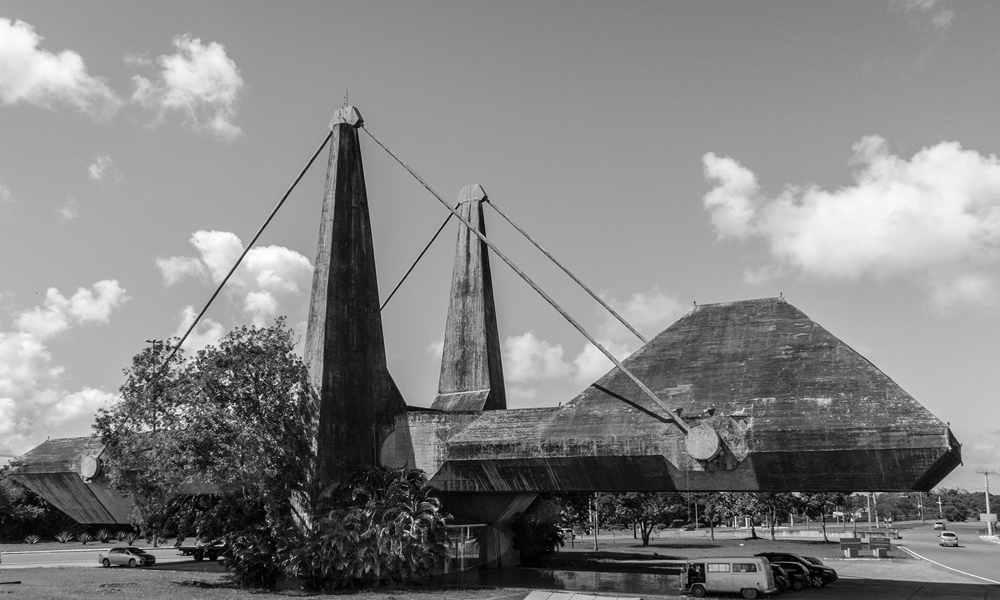
Architect João da Gama Filgueiras Lima aka Lelé: Centro de Exposições do Centro Administrativo da Bahia Image Laurent Etourneau
Is there a difference of opinion about Brutalism and the protection of buildings in Western Europe and the US versus the former Soviet Union?
How Brutalist buildings are treated differs from country to country. The UK and Germany have made great advances in listing more and more of them. However, heritage protection, in general, is much less common elsewhere. Too often, 1950s to 1970s buildings are still treated in a lower-tier when it comes to considering whether they are worthy of preservation.
Things are even more difficult in the former USSR because there, Brutalist monuments are also manifest reminders of the bygone communist rule. It’s not unusual to see governments steering clear of any association with them and in consequence, are they are very reluctant to preserve or even simply maintain them. The political connections of the architecture still impact the general public’s perception greatly. What is often forgotten or even not known is that Brutalist buildings were often designed by fiercely independent architects that tried to push the envelope as far as they could under party guidelines. That being said, these finer points understandably often get lost in today’s discourse. This makes it particularly difficult to separate architecture from politics.
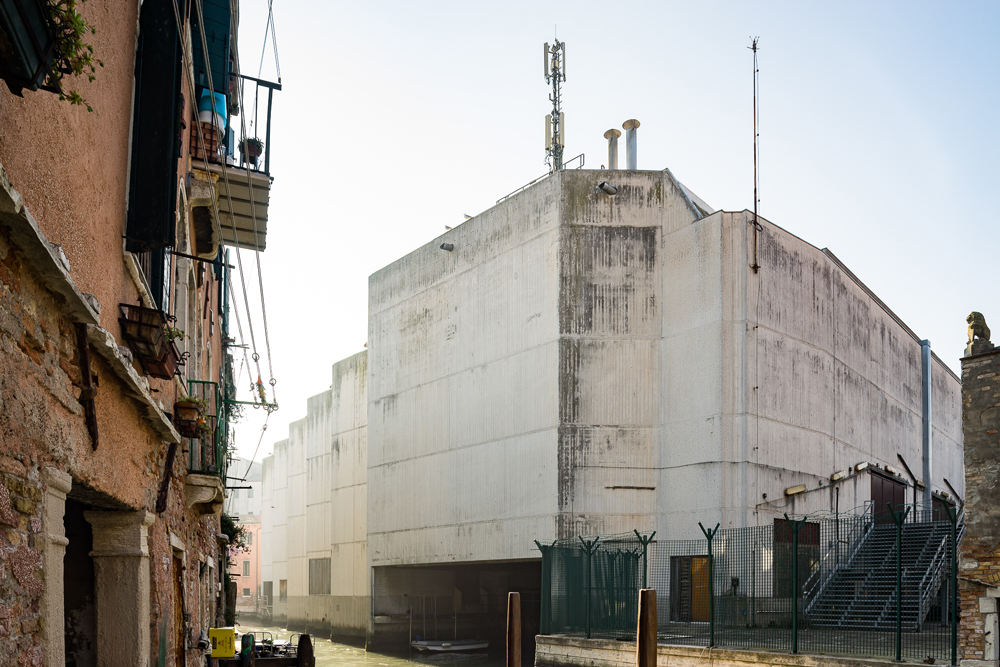
Architect: E. Capuzzo / G. Cocco: Palasport Giobatta Gianquinto, Venice, Italy, 1977 ©
Are Brutalist buildings liked by the public in Germany? Is there an old East-West divide and does age-group play a part?
There isn’t a strong East-West divergence, however, attitudes are still very much divided. While the general public still seems mostly skeptical, two groups, in particular, are rediscovering Brutalism as something special:
First, young people that have a more unbiased approach and, who thanks to the internet, discover a whole microcosm of this extraordinary design language. Second, professionals in the fields of architecture and architectural history. After the big ideological battles of the ’80s and ’90s have long been fought, they are now able to look back with the perspective of hindsight. There is a genuine appreciation of Brutalism which in some cases goes even further. I can spot Brutalist influences returning in contemporary architecture.
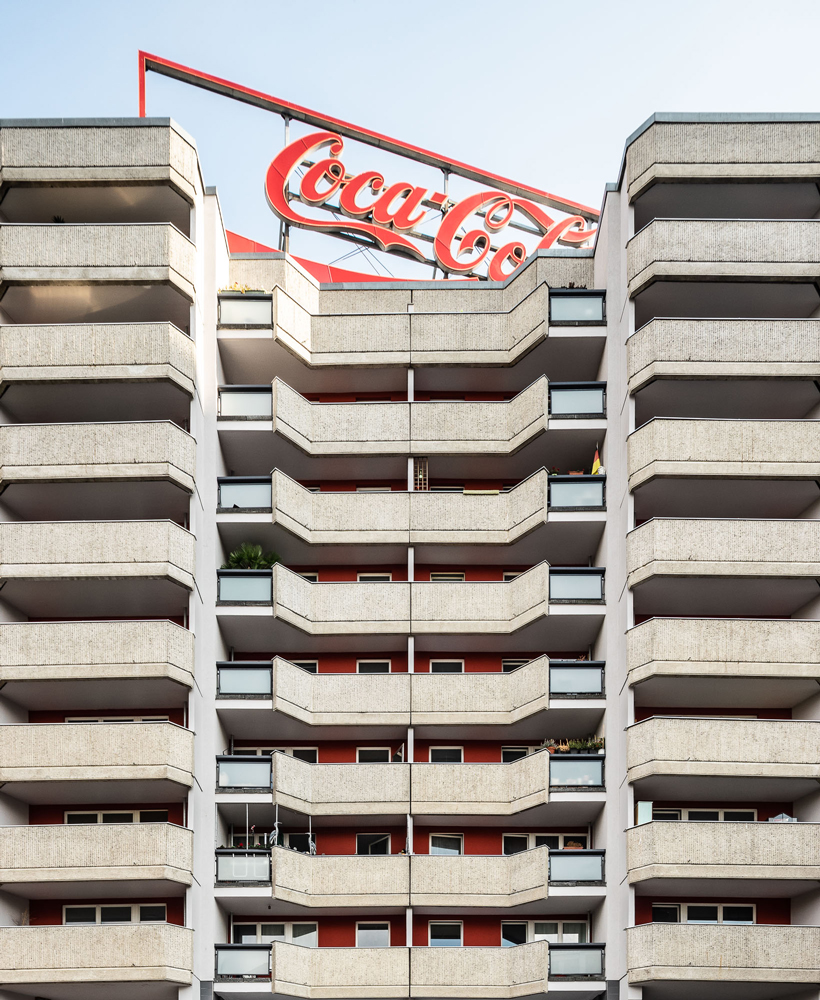
Architects: VEB BMK (Eckart Schmidt): Spitteleck, Berlin, Germany, 1980–1985 ©
Has COVID-19 impacted on your work?
Thankfully the database and our communications were all able to continue as everything is done over the internet. Our physical exhibition, which was planned to open at the JUT Foundation in Taipei had to be postponed, but it recently successfully opened. Unfortunately, we were not able to travel there for the opening.
On a personal level, as part of my PhD research, I had planned field trips to East Asia and Latin America which were postponed, I hope to be able to pick up on those trips in 2021.
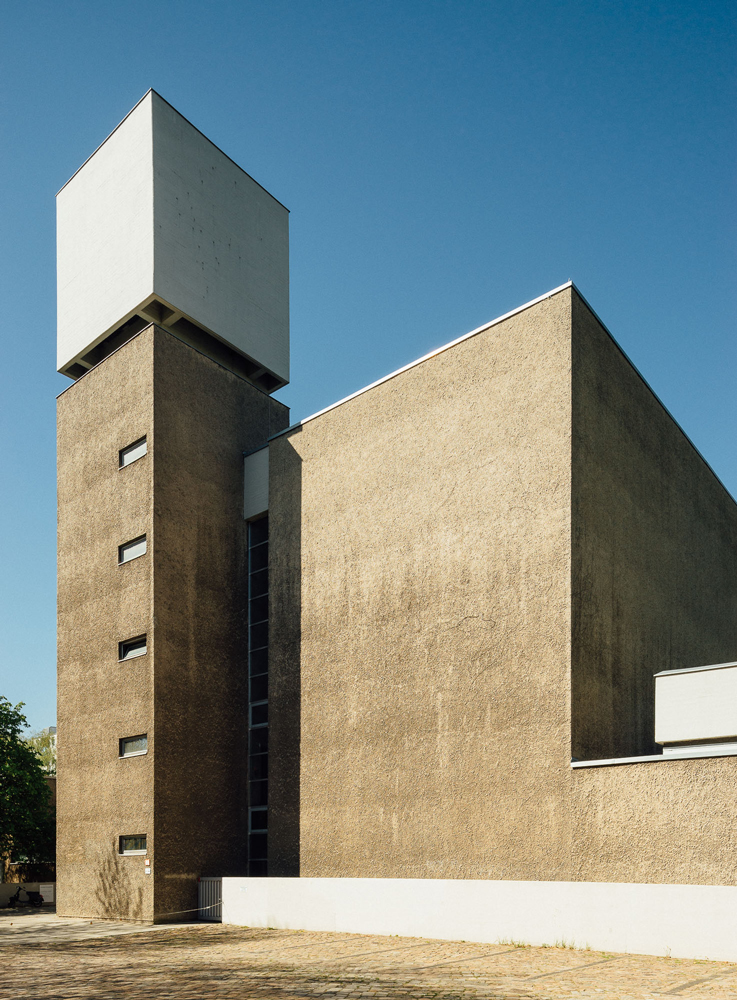
Architects: Werner Düttmann: St. Agnes (today: König Galerie), Berlin, Germany, 1965–1967 ©
Are there any upcoming exhibitions we should know about?
SOS Brutalism is currently on view at the JUT Foundation in Taipei from July 4 – November 11 2020. It features newly built models and an extended chapter about Brutalism in Taiwan. In addition, the exhibition Böhm 100 at the Deutsches Architekturmuseum in Frankfurt celebrates the marvellous Neviges Pilgrimage Church on the occasion of architect Gottfried Böhm’s 100th birthday from January 17 – September 27 2020.
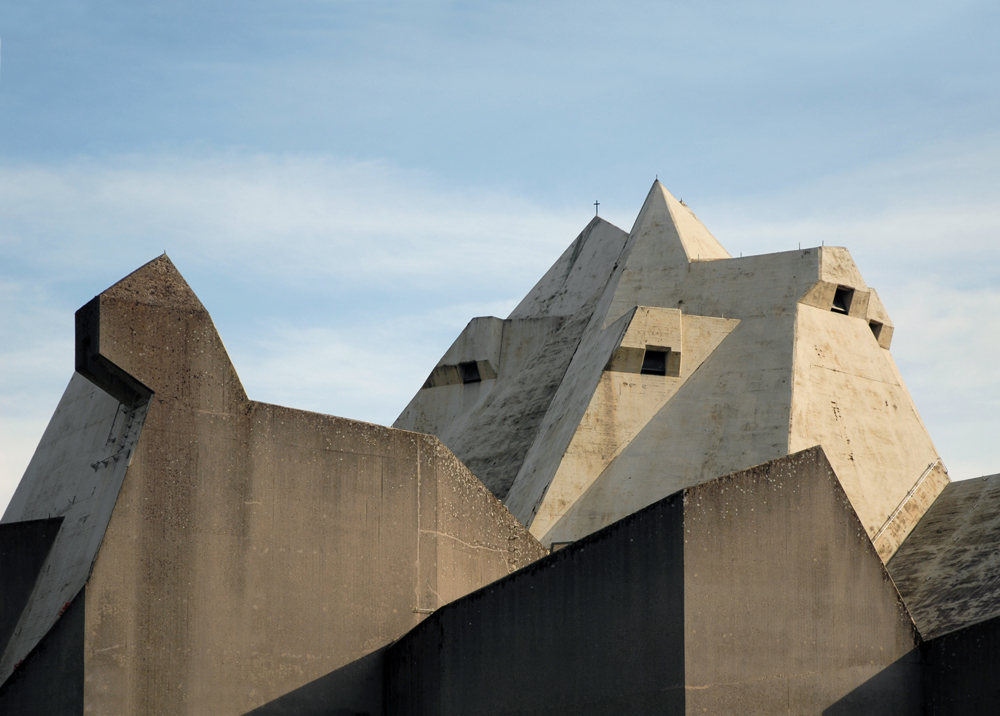
Architect Gottfried Böhm Mary Queen of Peace, Kohnigin des Friedens pilgrimage church Image Elya CC BY 2.0
Quickfire Greyscape:
How can we access the database?
http://www.sosbrutalism.org/
Any publications?
- SOS BRUTALISM: A Global Survey
- Coming in 2021 is the Brutalist Berlin Map by Blue Crow Media, which I recently worked on
And for you?
I am currently writing my PhD on what I think is a revival of Brutalism in contemporary architecture.
Fav non-brutalist building?
Ulmer Münster (Ulm is my home town)
Film you’ve watched too many times but still can’t resist?
2001: A Space Odyssey
Top three must-see buildings in Germany for lovers of brutalism?
Mäusebunker, Neviges Pilgrimage Church, Ruhr Universität Bochum
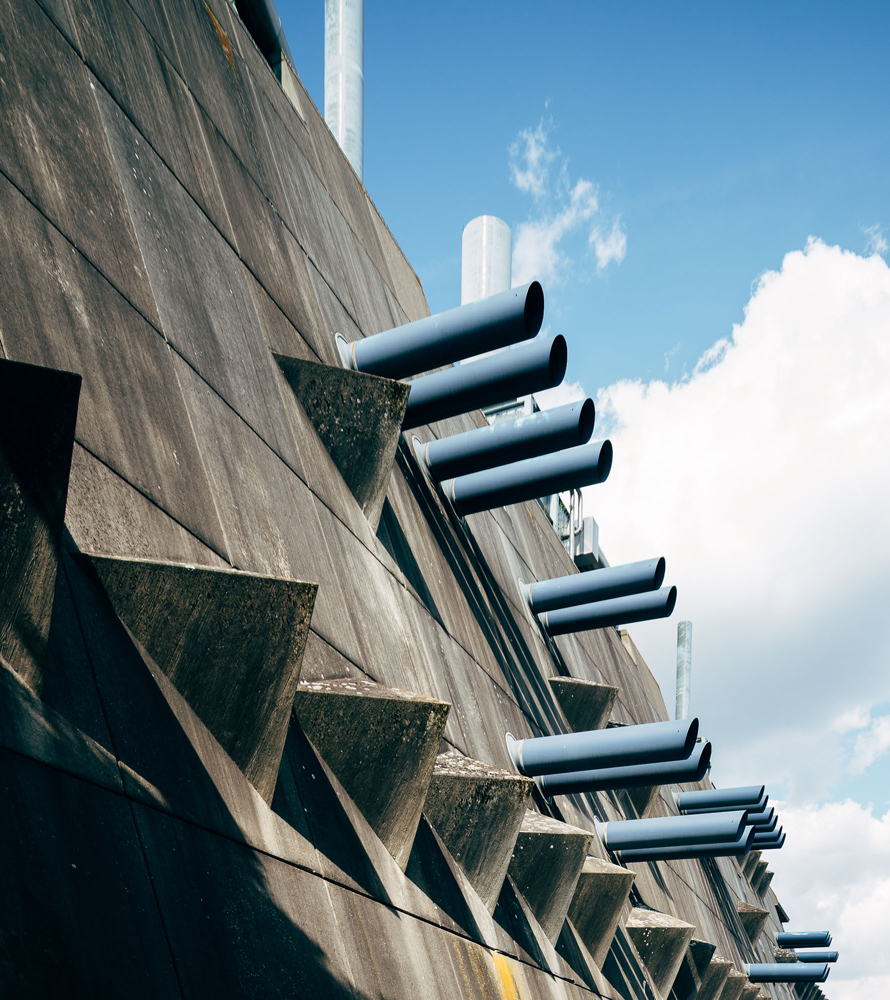
Architects Gerd Hänska / Magdalena Hänska / Kurt Schmersow: Central Animal Labs „Mäusebunker“ Berlin 1971–1980©
German dish we must all try?
Maultaschen
Fav artist (painting or music your choice)
Victor Vasarely
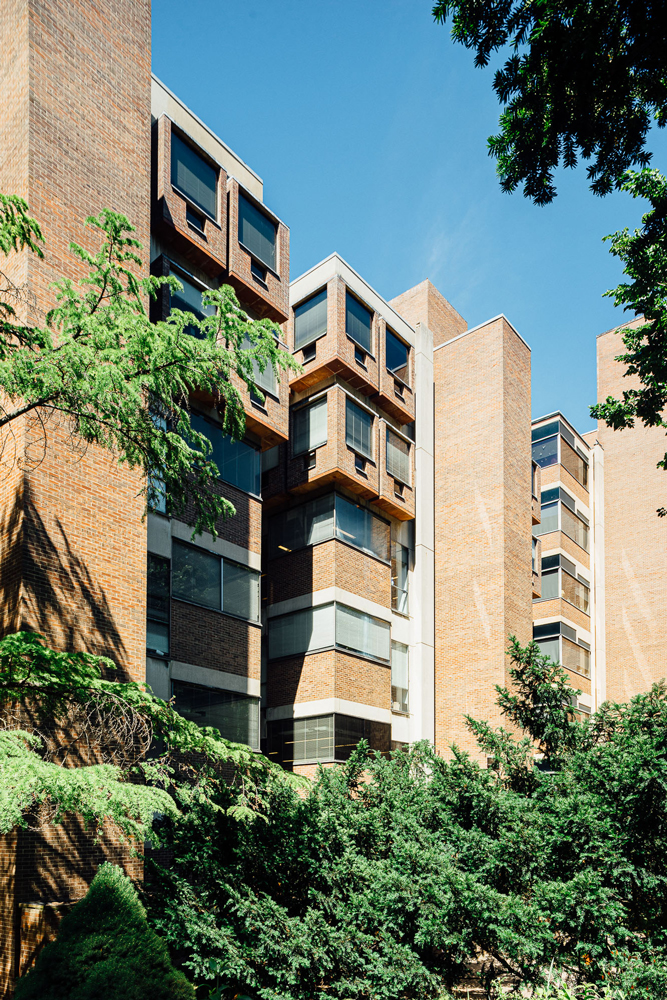
Louis Kahn: Richards Medical Research Laboratories, University of Pennsylvania 1957–1965 ©
Check out the database – here’s the listings for Felix’s photos
Central Post Office Marburg http://sosbrutalism.org/cms/15889935
Corbusierhaus.jpg http://sosbrutalism.org/cms/18559177
Hygieneinstitut http://sosbrutalism.org/cms/15890561
Mailman Center for Child Development http://sosbrutalism.org/cms/15892327
Marl City Hall http://sosbrutalism.org/cms/16271739
Mäusebunker http://sosbrutalism.org/cms/15889871
Palasport Giobatta Gianquinto http://sosbrutalism.org/cms/16586506
Pforzheim City Hall http://sosbrutalism.org/cms/16678515%5D
Reineke-Fuchs-Grundschule http://sosbrutalism.org/cms/16031391
Richards Medical Research Laboratories http://sosbrutalism.org/cms/18801956
South-Kendall Campus http://sosbrutalism.org/cms/16502027
Spitteleck http://sosbrutalism.org/cms/18861789
St. Agnes – König Galerie http://sosbrutalism.org/cms/18861789
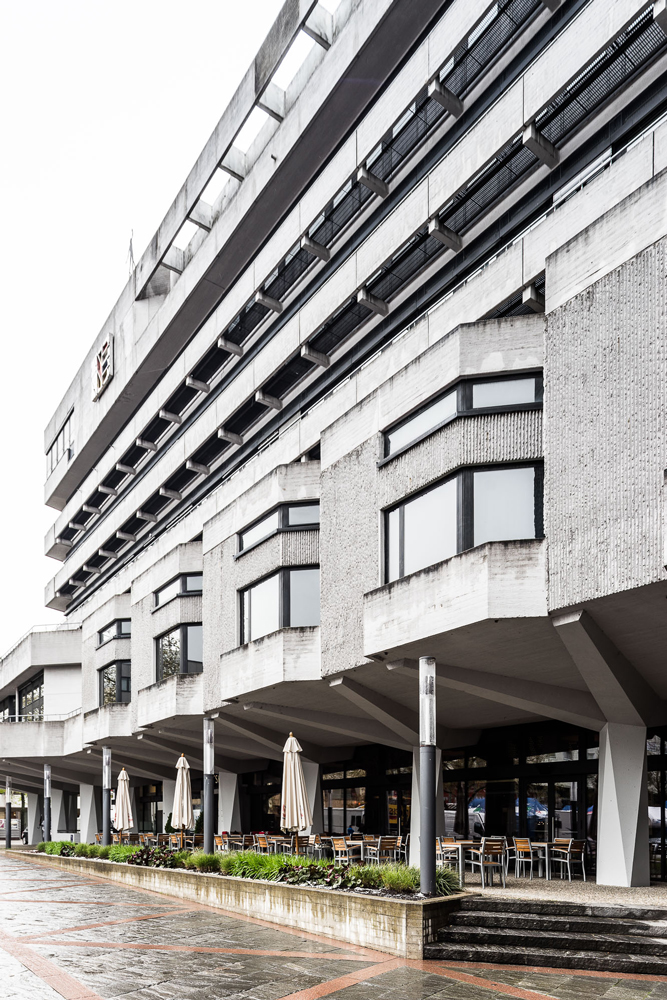
Architect: Rudolf Prenzel: City Hall, Pforzheim, Germany, 1959–1973, Photo: Felix Torkar
Get In Touch
Felix’s website: www.felix-torkar.de
https://www.instagram.com/flxtrkr/
DAM online Deutsches Architekturmuseum
Wüstenrot Stiftung online Wüstenrot Stiftung.
All images are the Copyright of Felix Torkar ©




